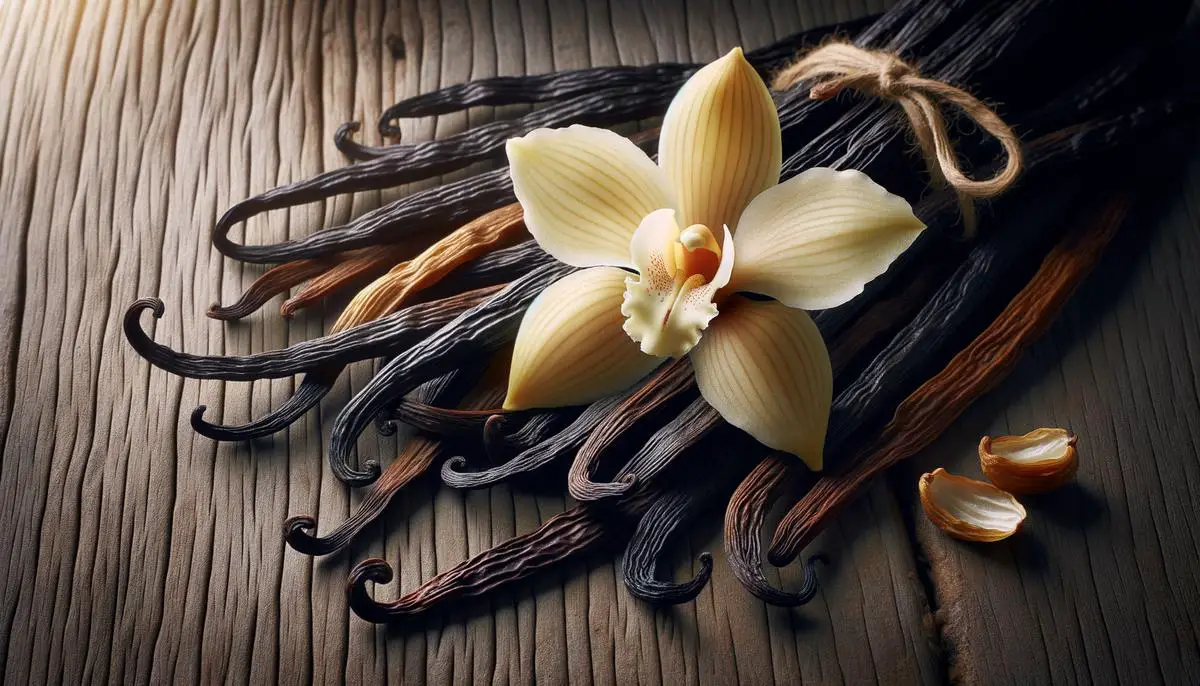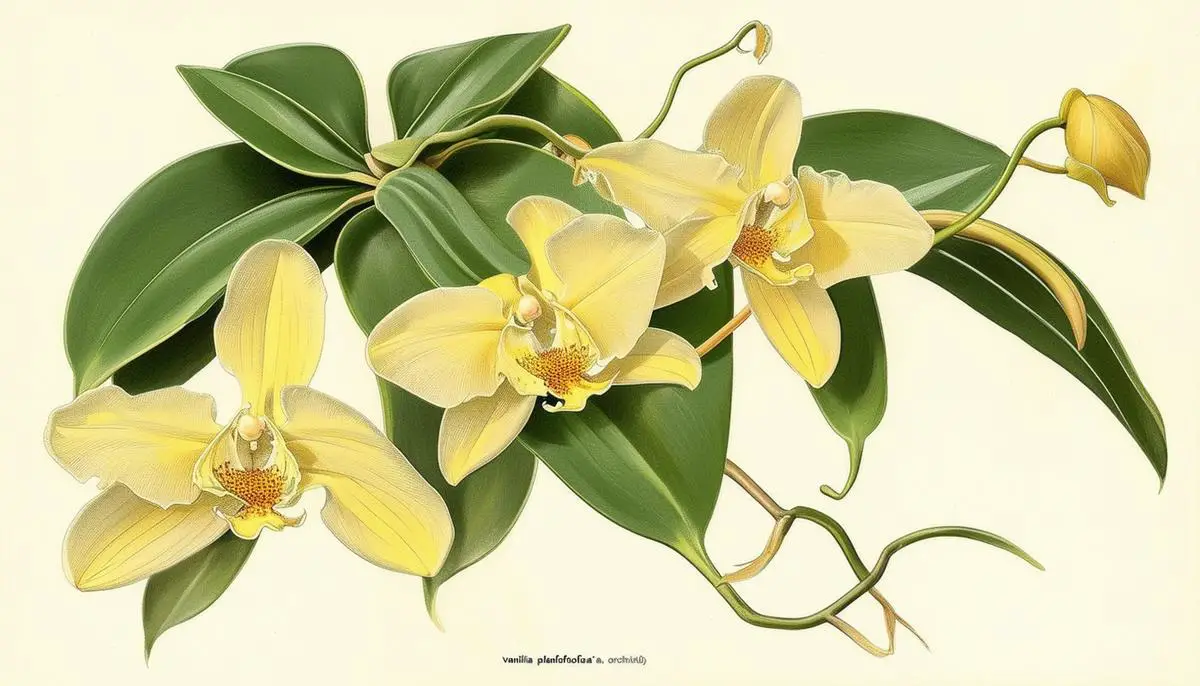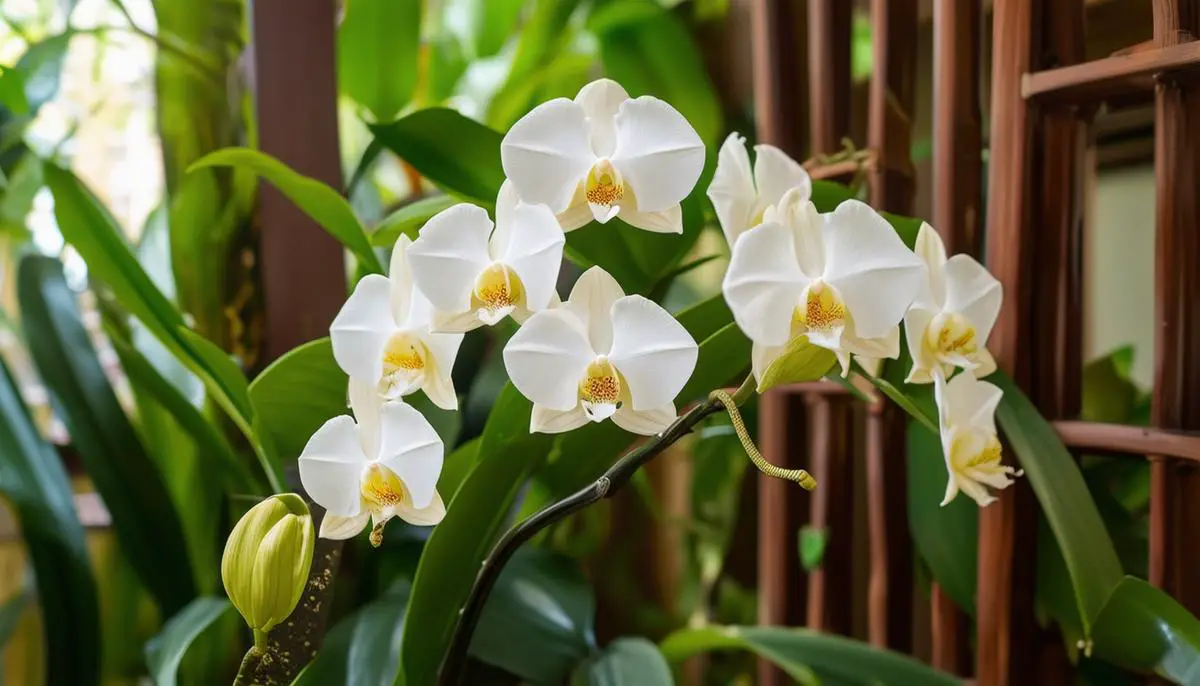
Vanilla Bean Basics
Vanilla, derived from the orchid species Vanilla planifolia, stands out in the spice world for its rich flavor and complex cultivation process. Native to Mexico and Central America, this orchid is the only one among the vast family that provides an edible fruit, the coveted vanilla bean.
The vanilla plant does not reach maturity to produce pods until about three years into its growth. The flowers that eventually sprout open only briefly—an ephemeral window of just one day for pollination. In its native habitat, the delicate blossoms are naturally pollinated by specific local bees. However, outside Mexico, each flower must be hand-pollinated within this short window to ensure pod production, contributing to vanilla's labor-intensive and costly nature.
Once pollination is successful, the beans take an additional nine months of growth on the vine before they are ready to be harvested. Post-harvest, the beans undergo a curing process lasting several months, transforming the initially scentless green pods into the aromatic, dark brown beans beloved across the globe.
Vanilla requires a specialized climatic embrace similar to that of its native tropics—high humidity coupled with adequate shade and support for climbing. From cultivation to curing, each bean encapsulates a narrative of botanical dedication to creating pleasure through craftsmanship and ancient floricultural knowledge.

Cultivation Challenges
The cultivation of vanilla, marked by its labor-intensive processes and particular climatic needs, reveals a world where tradition meets precision. As the second most expensive spice after saffron, the journey from plant to product demands time, precision, and harmony with nature1.
Hand-pollination, a meticulous practice essential outside its native Mexican climes, exemplifies such specialized labor. Each orchid must be pollinated manually, replicating the natural act performed by the elusive Melipona bee, exclusive to Mexico. During peak flowering season, skilled workers navigate through acres of orchids, carefully pollinating thousands of short-lived blooms, each open for just one precious day.
Once hand-pollinated, the vines require an exact recipe of environmental conditions to thrive—a mix of high humidity, indirect bright sunlight, and particular soil compositions rich in organic matter. Vanilla vines are climbers, demanding careful training and support throughout trellises to reach upwards. Any deviation from optimal conditions can significantly affect the plant's yield.
Regions ideal for vanilla cultivation are few, each challenged by its microclimates and terrain. For instance, Madagascar's tropical wet and dry climates offer a contrast to the constantly humid weather preferred by vanilla, requiring growers to adeptly manage cultivation methods seasonally2. These efforts culminate in an intricate dance around climate change, as variability in weather patterns could upset the fragile balance required, affecting harvests worldwide.
The recurring investment in effort, substantial manual labor, and the years waiting for a single harvest contribute to vanilla's high prices. Each luxurious scoop of vanilla-infused delight is a nod to this venerable craftsmanship—a taste luxuriously crafted against the odds of nature and nurtured by human hands seasoned with experience and persistence.

Harvesting and Curing Process
The rhythm of harvesting vanilla begins after substantial waiting and constant mindful care of the orchid. Approximately nine months following pollination, the green beans mature, awaiting careful human interaction at harvest.
Harvesting these pods is an exercise in precision timing. Each pod must be picked when it is fully-grown yet before it ripens. The optimal period is marked when the tip of the bean begins to turn yellow—a sign the pods are full of potential flavors and aromas. This step is crucial as underripe or overripe pods can result in suboptimal flavor development.
Following harvest, the enigmatic art of curing begins—an elaborate process that awakens the dormant flavors hidden within each bland green pod. The initial stage, called "killing," gently stops the pod's natural maturation and enzymatic processes. Various methodologies such as blanching in hot water, freezing, or exposure to sunlight can be employed, although traditional sun-wilting is most commonly preferred.
After the pods have been 'killed', they enter the sweating phase, involving wrapping the beans in woolen blankets or storing them in wooden boxes to sweat overnight. This process allows the beans to ferment lightly, developing their characteristic brown color and bringing forward rich, complex flavors. The beans are then laid under the sun during the day and returned to sweat by night, a pattern that continues for up to 20 days.
Once the sweating phase concludes, the now-brown and pliant pods transition into the drying phase. The slow drying period, which can last several months, must be carefully controlled to preserve essential oils and aroma compounds within the vanilla. Pods are intermittently laid out in the sun and returned to shade, painstakingly monitored to ensure they do not over-dry.
Every aspect of vanilla's harvesting and curing process contributes vitally to the quality of the final product. The climate, the timing of each step, and the artisanal expertise applied during curing influence the bean's aromatic richness, making the curing process not merely a chemical necessity but a craft predicated on sophistication.

Growing Vanilla at Home
Growing vanilla at home combines the allure of cultivating one of the most adored flavors in the world with the satisfaction of tending an exquisite orchid plant. Embarking on this endeavor demands dedication and understanding of the plant's intricate growing conditions.
Vanilla planifolia thrives on warmth, ample humidity, and filtered, abundant light. Before you begin, ensure you can simulate these elements within your home or greenhouse to provide your vanilla orchid the environment it needs to flourish.
Soil Requirements:
The ideal substrate for growing vanilla is loose, rich in organic material, and well-draining. A blend commonly used is a mix of finely chopped bark or coconut husk, which allows for quick drainage yet retains sufficient moisture. Maintaining a neutral to slightly acidic pH (6.6 to 7.5) is vital for the health of your plant.
Temperature and Humidity:
The perfect daytime temperature range lies between 80°F to 95°F (27°C to 35°C), with a slight drop at night but no lower than 60°F (15°C). High humidity levels, around 60% to 80%, are crucial and can be achieved with regular misting or using a humidifier.
Lighting:
Sunlight should be indirect to simulate the dappled light of tropical forests. Near a bright, sunny window with a sheer curtain is an ideal spot. Beware of too much direct sunlight, which can scorch the leaves.
Pollination and Cultivation Tips:
If your vanilla orchid blooms, pollinating will be your next challenge. As blooms only last one day, mimicking the task once reserved for the native Melipona bee is crucial. Using a small tool, gently lift the rostellum and press the pollen from the anther onto the stigma.
Ongoing Care:
Ongoing care involves supporting the climbing behavior of your vanilla orchid with stakes or trellises. Regularly pruning any dead or diseased parts of the plant will help prevent fungal infections and encourage healthy growth. Fertilization should be conservative, with orchid-friendly fertilizer applied every few weeks during the growing season. Overwatering must be cautiously avoided to prevent root rot.
Remember, growing vanilla at home is a potentially lifelong journey akin to a botanical adventure, filled with nuances that might well reward you with the world's beloved vanilla pod.

In every aromatic scoop of vanilla-infused delight, we appreciate not just a flavor but a narrative steeped in agricultural artistry and climatic challenges. The essence of vanilla transcends mere taste, offering a glimpse into the enduring spirit of those who cultivate and curate this revered spice. It reminds us of how nature's gifts are enhanced through human effort and passion, crafting an experience that touches both the palate and the heart.
- Ranadive AS. Vanilla cultivation. Food Sci Technol. 2003;21(2):155-161.
- Rakotomalala JJR, Rasoarahona F, Ramanjehimanana A, Ramanoelina PAR, Gaydou EM. Volatile compounds of the Vanilla tahitensis x Vanilla pompona hybrids in Madagascar. Food Chem. 2005;90(4):699-703.



